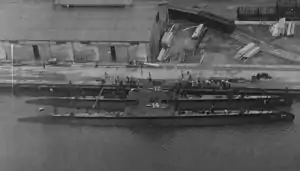HNLMS O 14
O 14 was a O 12-class submarine of the Royal Netherlands Navy that saw service during World War II. It was built by the Koninklijke Maatschappij De Schelde of Vlissingen[1] and entered active duty on 4 March 1934.
 HNLMS O 12 and O 14 in the harbor of San Juan, Puerto Rico (1937 | |
| History | |
|---|---|
| Name: | O 14 |
| Builder: | Koninklijke Maatschappij De Schelde, Vlissingen |
| Laid down: | 29 December 1928 |
| Launched: | 3 October 1931 |
| Commissioned: | 4 March 1932 |
| Decommissioned: | 26 June 1943 |
| General characteristics | |
| Class and type: | O 12-class submarine |
| Displacement: |
|
| Length: | 60.4 m (198 ft 2 in) |
| Beam: | 6.8 m (22 ft 4 in) |
| Draught: | 3.6 m (11 ft 10 in) |
| Propulsion: |
|
| Speed: |
|
| Range: | |
| Complement: | 29-31 |
| Armament: |
|
Just before the start of World War II O 14 was in Curaçao. Because there was no need on the Allied side for a Dutch submarine to be stationed there, O 14 returned to Europe. Based in England, it did patrol duty off the coast of Norway, with convoy Convoy HX 79, and was decommissioned in 1943 due to a lack of replacement engines.
Service history
Before World War II
Just after entering service O 14 received a visit from Duke Henry of Mecklenburg-Schwerin and Defence Minister on the occasion of the 25th anniversary of the Royal Netherlands Navy Submarine Service. In 1937, O 14 travelled to Curaçao with sister ship O 12, and again in 1939, this time with sister ship O 13.[2]
During World War II
During the German invasion of the Netherlands in 1940, O 14 was stationed in Curaçao with sister ship O 15, where both were receiving maintenance.[2]
Consultations between the Dutch and British Navy resulted in the decision to move O 14 and O 15 to Europe, since there was no need for Dutch submarines in the Caribbean. Both ships went via Kingston, Bermuda, and Halifax to England. O 14 underwent repairs at Halifax Shipyard on its armament. Since there was a lack of distilled water for the ship's batteries, O 14 could not join Convoy HX 78, but had to wait until October 1940, for Convoy HX 79. On 19 October a German wolfpack attacked the convoy, which sank 12 of the 45 ships and damaged another. O 14 was attacked as well, but all three torpedoes fired at the ship missed their target.[2]
On 22 October 1940, O 14 arrived in Rothesay, Bute, and with O 9 and O 10 was used as a target ship during tests with the ASDIC sonar system. From 22 December 1940, O 14 was stationed in Dundee, where maintenance was done and the batteries replaced. Until August 1941 O 14 again served as the target ship for ASDIC tests in Scapa Flow.[2]
From 8 August 1940, to January 1941, O 14 patrolled the coast of Norway without being able to attack any enemy ships. In January 1942 O 14 participated in Operation Kitbag, where it was placed 15 nautical miles (28 km; 17 mi) off the Norwegian coast and used as a radio beacon for destroyers on their way to the fjord at Hell, Norway. At the end of January and the start of February O 14 was involved with the unsuccessful search for the German battleship Tirpitz. Afterward O 14 was used as a target ship for anti-submarine warfare exercises in Scapa Flow, and then did three more patrols off the Norwegian coast, again without attacking enemy ships.[2]
After those last patrols there was trouble with the diesel engines. Given the lack of parts, the severity of the problems, and the age of O 14 it was decided to decommission the sub. Parts were used in the repair of sister ship O 15. The Dutch crew was then stationed on a sub loaned from the British Navy, HMS Sturgeon, which was renamed Zeehond.[2]
References
- (in English) Dutchsubmarines.com :: O 12 class
- (in English) Dutchsubmarines.com :: O 14